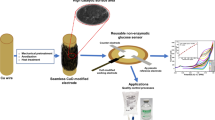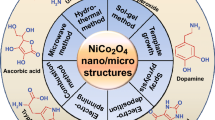Abstract
An amperometric glucose biosensor was developed based on the immobilization of glucose oxidase in the organically modified silicate (ormosil)-polyvinyl acetate (PVA) matrix onto a Prussian Blue (PB)-modified glassy carbon electrode. A higher stability PB-modified electrode was prepared by the electrochemical deposition of FeCl3, K3[Fe(CN)6] and ethylenediamine tetraacetic acid (EDTA) under cyclic voltammetric (CV) conditions. The effects of the potential range of CV conditions, electrolyte cations, applied potential, pH, temperature and co-existing substances were investigated. The detection limit of the glucose biosensor was 8.1 μmol·L−1 (S/N = 3) with a linear range from 20 μmol·L−1 to 2 mmol·L−1 (R = 0.9965). The biosensor presented a fast response and good selectivity. Additionally, excellent reproducibility and stability of the biosensor were observed.
Similar content being viewed by others
References
Chen X H, Hu Y B, Wilson G S. Glucose microbiosensor based on alumina sol-gel matrix/electropolymerized composite membrane. Biosens Bioelectron, 2007, 17: 1005–1013
Yang H, Chung T D, Kim Y T, Choi C A, Jun C H, Kim H C. Glucose sensor using a microfabricated electrode and electropolymerized bilayer films. Biosens Bioelectron, 2007, 17: 251–259
Pandey P C, Upadhyay S. Bioelectrochemistry of glucose oxidase immobilized on ferrocene encapsulated ormosil modified electrode. Sens Actuators B Chem, 2001, 76: 193–198
Karyakin A A, Karyakina E E, Gorton L. Prussian-blue-based amperotric biosensors in flow-injection analysis. Talanta, 1996, 43: 1597–1606
Liu Z L, Liu H, Zhang M, Kong J L, Deng J Q. Al2O3 sol-gel derived amperometric biosensor for glucose. Anal Chim Acta, 1999, 392: 135–141
Chi Q J, Dong S J. Amperometric biosensors based on the immobilization of oxidases in prussian blue film by electrochemical codeposition. Anal Chim Acta, 1995, 310: 429–436
Li T, Ya Z H, Ding L. Development of an amperometric biosensor based on glucose oxidase immobilized through silica sol-gel film onto prussian blue modified electrode. Sens Actuators B Chem, 2004, 101: 155–160
Tan X C, Tian Y X, Cai P X, Zou X Y. Glucose biosensor based on glucose oxidase immobilized in sol-gel chitosan/silica hybrid composite film on Prussian Blue modified glass carbon electrode. Anal Bioanal Chem, 2005, 381: 500–507
Zhang N, Wilkop T, Lee S, Cheng Q. Bi-functionalization of a patterned prussian blue array for amperometric measurement of glucose via two integrated detection schemes. Analyst, 2007, 132: 164–172
Xue M H, Xu Q, Zhou M, Zhu J J. In situ immobilization of glucose oxidase in chitosan-gold nanoparticle hybrid film on Prussian Blue modified electrode for high-sensitivity glucose detection. Electrochem Commun, 2006, 8: 1468–1474
Xian Y Z, Hu Y, Liu F, Xian Y, Feng L J, Jin L T. Template synthesis of highly ordered prussian blue array and its application to the glucose biosensing. Biosens Bioelectron, 2007, 22: 2827–2833
Yang C, Wang C H, Wu J S, Xia X H. Mechanism investigation of Prussian Blue electrochemically deposited from a solution containing single component of ferricyanide. Electrochim Acta, 2006, 51: 4019–4023
Pan D W, Chen J H, Nie L H, Tao W Y, Yao S Z. Amperometric glucose biosensor based on immobilization of glucose oxidase in electropolymerized o-aminophenol film at Prussian Blue-modified platinum electrode. Electrochim Acta, 2004, 49: 795–801
Pan D W, Chen J H, Nie L H, Tao W Y, Yao S Z. An amperometric glucose biosensor based on poly(o-aminophenol) and Prussian Blue films at platinum electrode. Anal Biochem, 2004, 324: 115–122
Deng Q, Li B, Dong S J. Self-gelatinizable copolymer immobilized glucose biosensor based on Prussian Blue modified graphite electrode. Analyst, 1998, 123: 1995–1999
Zhuang R F, Yang T Z. Preparation and behavior of higher stability Prussian Blue modified electrode. Inorg Chem, 1989, 5: 80–85
Brandy J, White H, Harmon J. Novel optical solid-state glucose sensor using immobilized glucose oxidase. Biochem Biophys Res Commun, 2002, 292: 1069–1071
Doretti L, Ferrara D, Gattolin P, Lora S. Covalently immobilized enzymes on biocompatible polymers for amperometric sensor applications. Biosens Bioelectron, 1996, 11: 365–373
Li Z F, Kang E T, Neoh K G, Tan K L. Covalent immobilization of glucose oxidase on the surface of polyaniline films graft copolymerized with acrylic acid. Biomaterials, 1998, 19: 45–53
Yang X H, Hua L, Gong H Q, Tan S N. Covalent immobilization of an enzyme (glucose oxidase) onto a carbon sol-gel silicate composite surface as a biosensing platform. Anal Chim Acta, 2003, 478: 67–75
Chiu S H, Chung T W, Giridhar R, Wu W T. Immobilization of β-cyclodextrin in chitosan beads for separation of cholesterol from egg yolk. Food Res Int, 2004, 37: 217–223
Yang Y H, Yang M H, Wang H, Tang L, Shen G L, Yu R Q. Inhibition biosensor for determination of nicotine. Anal Chim Acta, 2004, 509: 151–157
Kwan R C H, Hon P Y T, Mak K K W, Renneberg R. Amperometric determination of lactate with novel trienzyme/poly(carbamoyl) sulfonate hydrogel-based sensor. Biosens Bioelectron, 2004, 19: 1745–1752
Tag K, Lehmann M, Chan C Y, Renneberg R, Riedel K, Kunze G. Measurement of biodegradable substances with a myceliasensor based on the salt tolerant yeast Arxula adeninivorans LS3. Sens Actuators B Chem, 2000, 67: 142–148
Ivanildo L M, Madalena C C A. Automated determination of glucose in soluble coffee using Prussian Blue-glucose oxidase-Nafion® modified electrode. Talanta, 2005, 66: 1281–1286
Dodevska T, Horozova E, Dimcheva N. Electrocatalytic reduction of hydrogen peroxide on modified graphite electrodes: Application to the development of glucose biosensors. Anal Bioanal Chem, 2006, 386: 1413–1418
Niculescu M, Gáspár S, Schulte A, Csöregi E, Schuhmann W. Visualization of micropatterned complex biosensor sensing chemistries by means of scanning electrochemical microscopy. Biosens Bioelectron, 2004, 19: 1175–1184
Chen D D, Cao Y B, Liu B H, Kong J L. A BOD biosensor based on a microorganism immobilized on an Al2O3 sol-gel matrix. Anal Bioanal Chem, 2002, 372: 737–739
Jiang Y Q, Xiao L L, Zhao L, Chen X, Wang X R, Wong K Y. Optical biosensor for the determination of BOD in seawater. Talanta, 2006, 70: 97–103
Lin L, Xiao L L, Huang S, Zhao L, Cui J S, Wang X H, Chen X. Novel BOD optical fiber biosensor based on co-immobilized microorganisms in ormosils matrix. Biosens Bioelectron, 2006, 21: 1703–1709
Nakane K, Yamashita T, Iwakora K, Suzuki F. Properties and structure of poly(vinyl alcohol)/silica composites. J Appl Polym Sci, 1999, 74: 133–138
Zhang X J, Wang J, Ogorevc B, Spichiger U E. Glucose nanosensor based on Prussian-Blue modified carbon-fiber cone nanoelectrode and an integrated reference electrode. Electroanal, 1999, 11: 945–949
Inzelt G. A quartz crystal microbalance study of the sorption of ions and solvent molecules in poly(tetracyanoquinodimethane) electrodes. J Electroanal Chem, 1990, 287: 171–177
Bácskai J, Martinusz K, Czirók E, Inzelt G, Kulesza P J, Malik M A. Polynuclear nickel hexacyanoferrates: Monitoring of film growth and hydrated counter-cation flux/storage during redox reactions. J Electroanal Chem, 1995, 385: 241–248
Herren F, Fischer P, Ludi A, Halg W. Neutron diffraction study of Prussian Blue, Fe4[Fe(CN)6]3·xH2O. Location of water molecules and long-range magnetic order. Inorg Chem, 1980, 19: 956–959
Buser H J, Sschwarzenbach D, Petter W, Ludi A. The crystal structure of Prussian Blue: Fe4[Fe(CN)6]3·xH2O. Inorg Chem, 1977, 16: 2704–2710
Itaya K, Ataka T, Toshima S. Spectroelectrochemistry and electrochemical preparation method of Prussian Blue modified electrodes. J Am Chem Soc, 1982, 104: 4767–4772
Dostal A, Kauschka G, Reddy S J, Scholz F. Lattice contractions and expansions accompanying the electrochemical conversions of Prussian Blue and the reversible and irreversible insertion of rubidium and thallium ions. J Electroanal Chem, 1996, 406: 155–163
Malik M A, Miecznikowski K, Kulesza P J. Quartz crystal microbalance monitoring of mass transport during redox processes of cyanometallate modified electrodes: Complex charge transport in nickel hexacyanoferrate films. Electrochim Acta, 2000, 45: 3777–3784
Abbaspour A, Kamyabi M A. Electrochemical formation of Prussian Blue films with a single ferricyanide solution on gold eletrode. J Electroanal Chem, 2005, 584: 117–123
Pournaghi-Azar M H, Dastangoo H. Palladized aluminum as a novel substrate for the non-electrolytic preparation of a Prussian Blue film modified electrode. J Electroanal Chem, 2004, 573: 355–364
Palma P, Paola B, Elisabetta A. PVA-gel (Lentikats) as an effective matrix for yeast strain immobilization aimed at heterologous protein production. Enzyme Microb Technol, 2006, 38: 184–189
Karyakin A A. Prussian Blue and its analogues: Electrochemistry and analytical applications. Electroanal, 2001, 13: 813–819
Yang X F, Zhou Z D, Xiao D, Choi M M F. A fluorescent glucose biosensor based on immobilized glucose oxidase on bamboo inner shell membrane. Biosens Bioelectron, 2006, 21: 1613–1620
Wu B L, Zhang G M, Shuang S M, Choi M M F. Biosensors for determination of glucose with glucose oxidase immobilized on an eggshell membrane. Talanta, 2004, 64: 546–553
Kamin R A, Wilson G S. Rotating ring-disk enzyme electrode for biocatalysis kinetic studies and characterization of immobilized enzyme layer. Anal Chem, 1980, 52: 1198–1205
Author information
Authors and Affiliations
Corresponding author
Additional information
Supported by the National High Technical Development Project (863 project) Foundation (Grant No. 2006AA09Z160) and the National Natural Science Foundation of China (Grant No. 20775064)
Rights and permissions
About this article
Cite this article
Chen, H., Zhao, L., Chen, X. et al. Development of an amperometric glucose biosensor based on the immobilization of glucose oxidase in an ormosil-PVA matrix onto a Prussian Blue modified electrode. Sci. China Ser. B-Chem. 52, 1128–1135 (2009). https://doi.org/10.1007/s11426-009-0146-4
Received:
Accepted:
Published:
Issue Date:
DOI: https://doi.org/10.1007/s11426-009-0146-4




